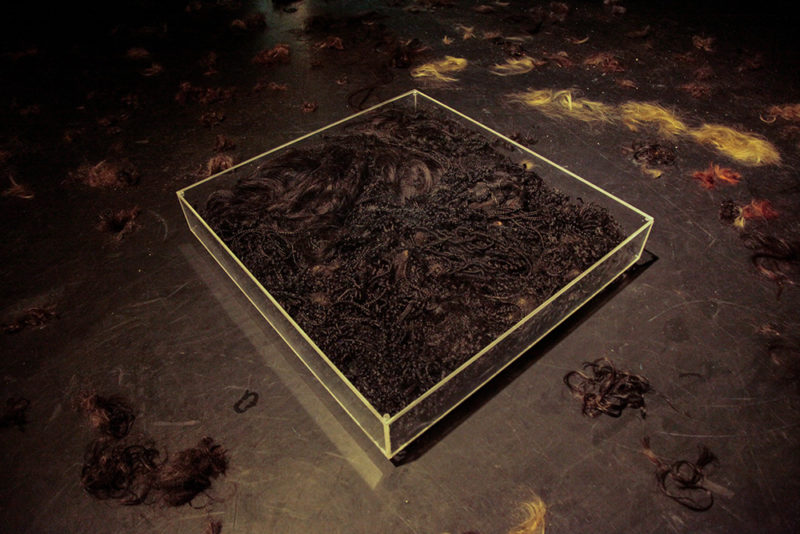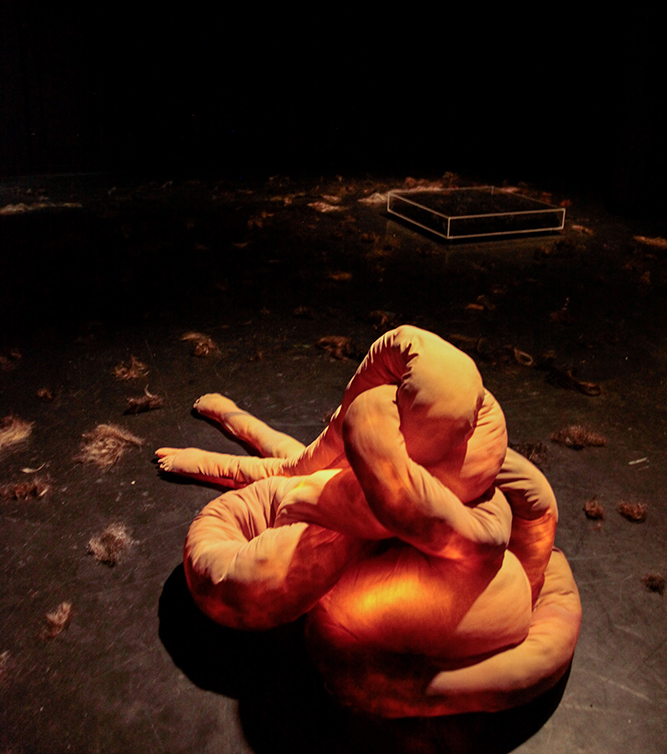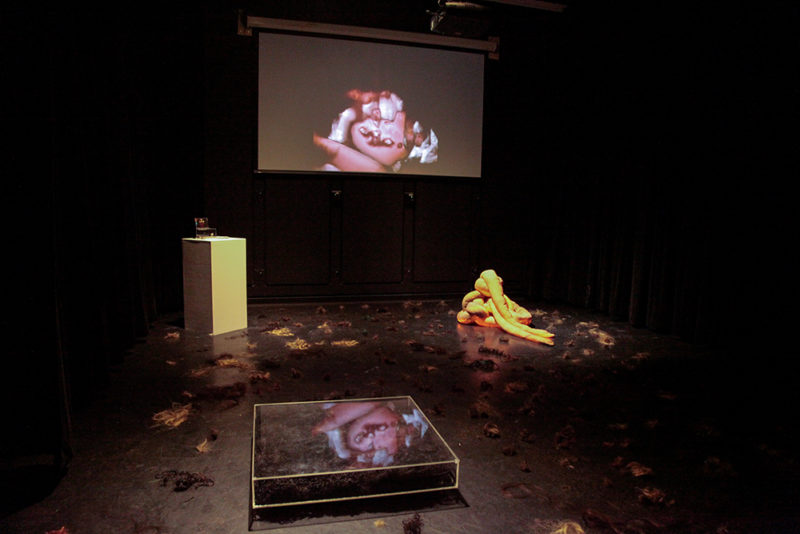The Dialogue Between Bodily Boundaries & Everything Else
28 January 2023By Kalina Nedelcheva

Walking into Sacred Spit, curated by Lea Rose Sebastianis in Open Space Gallery’s “Black Box,” felt like crossing the threshold of a site teeming with unruly spirits and transgressive energies. Illuminated by soft spotlights, three artworks by Karice Mitchell, Lauren Pirie, and Noelle Perdue come together in a simple installation against the backdrop of theatrical black curtains. At the corner of the Black Box and diagonal to the entrance, a little translucent box sits atop a white plinth. The sign reads “Prayer Requests.” The show explores how the complicated theme of the grotesque manifests in spheres of degradation and divinity. It destabilizes and shifts the boundary that separates the perverted and the sacred in human consciousness. In fusing them, Sebastianis creates a discernable tension that juxtaposes a sense of stillness with the hurricane of what she deems “the boundless body”—a body with no limits that absorbs its environment to inspire “an intrinsic unity with human, animal, and natural worlds.”1 These anarchic artworks tell corporeal stories. Amidst them, and in the darkness of the Black Box, the viewer loses their sense of separation between the embodied self and the contents of the exhibition. The “Prayer Box” catches visitors red-handed in the middle of the grotesque space of boundless bodies and fluid lust, inviting one to repent, confess, and show desire.
Karice Mitchell’s 1b and 52″ (2021) greets spectators as they enter the space. The piece consists of a low plexiglas box that is about the size of a small pallet. The container is filled with hair clippings, which were collected by the artist over the course of two years. The hair strands vary in appearance—from thin braids and twists that have retained their perfect shapes, to loose strands that run the gamut of soft and coarse textures. Accented with product buildup and dirt that Mitchell intentionally preserved, 1b and 52″ signifies a sense of longevity and persistence, both on cultural and personal levels. As Sebastianis points out in her curatorial thesis: “[the artwork] references the body without the body being present.” In the context of Black womanhood, which Mitchell explores through her work, this reference calls attention to the ways in which non-white people navigate the complicated limits of visibility (not “fitting in,” or being hypervisible) and invisibility (not being represented authentically, or being ignored altogether). With this work, the artist confronts the viewer with the specific presence of the absent Black body. In the grotto, as Sebastianis calls it, the collection of hair and its container blur the relationship of the self to the body, the line between the visible and the invisible, and the location of identity within the systemic structures that limit it.

Positioned diagonally to 1b and 52″, Lauren Pirie’s Fluid Exchange (2022) glows with its soft intertwined form. The knotted pile has a flesh-coloured exterior and is gently illuminated by an inner LED light. Out of this knot, two “feet” emerge. Faded patches of dirt and a line that passes through the top of one foot complicate the composition. Fascinated with the relationship between humans, nature, and the divine, the artist uses nonhuman forms imbued with human qualities. In Fluid Exchange, Pirie evokes the serpentine form through the long round tube that twists and knots, combining it with the semblance of humanity as two legs emerge from the intertwinement. Pirie further unsettles the viewer as her work is caught in a state of in-betweenness—the human form becoming coiling and sinuous. The artworks in Sacred Spit clearly display different states of duality: While Mitchell comments on states of visibility and invisibility, Pirie embraces the human-animal hybrid. The relationship between the anthropoid and the ophidian extends to the exhibition’s conceptual investment in the holy and the grotesque—the human as the saint and the serpent as the sinner.
Adding yet another dimension of duality to the exhibition, Noelle Perdue’s video work Blue Screen (2021) plays above Pirie’s soft sculpture. The work questions ideas of physical boundaries and euphoric entanglement between two or more bodies. Blue Screen is an experimental porn film, made with an algorithm that Perdue fed with masterful sequences from the “golden age” of porn (1969-1984). Shapeless silhouettes that morph into each other dominate the wall. The contours of these bodies are indistinguishable and fluid, causing the sexual act to come off as grotesque in its brazenness. Yet the rhythm of these acts and the shades of pink flashing from the screen suggest a harmony and a oneness of unidentified flesh. One is pushed to decipher the changing, nebulous shapes—a pair of breasts, two people in a passionate kiss, an obscured face superimposed on a serene lake surrounded by trees, a person looking over their shoulder. Viewers become mesmerized and soothed by the fluid dynamic of Blue Screen, especially in the almost pious silence of the exhibition space.

Strands of brown, blonde, red, and blue hair adorn the Black Box’s floor, seemingly fostering another layer of connection between the artworks. Collected over the span of a month by the curator, these clippings invoke an eeriness that either repulses or intrigues visitors, who move through the space with curiosity and caution towards Sebastianis’ curatorial choices. The three works in Sacred Spit share alluring formal qualities—the complex lines in 1b and 52’’, the knotting of Fluid Exchange, the soothing transitions of Blue Screen. Whether they are perceived as disturbing, balanced, disgusting, pleasing, uncomfortable, or venerated, the artworks function as shrines to the grotesque body. The religious motif inscribed into the topology of Sacred Spit enforces this, as the “Prayer Box” cuts through the cohesion of the artists’ shrine-like works and beckons the visitor to interact with these understandings of the grotesque, the divine, and their embodied self. The prayer box is full to the brim at the time of my visit; there must have been many things to confess in this mystical grotto.
- Lea Rose Sebastianis, “Sacred Spit” (MFA Thesis, OCAD University, 2022), i. http://openresearch.ocadu.ca/id/eprint/3666/1/Sebastianis_LeaRose_2022_MFA_CCP_Thesis.pdf
Sacred Spit ran from March 1 – 13, 2022, at The Open Space Gallery “Black Box” in Toronto, ON.
Feature Image: Installation view of Sacred Spit. Photo by Kat Zoumboulakis, courtesy of Lea Rose Sebastianis.



